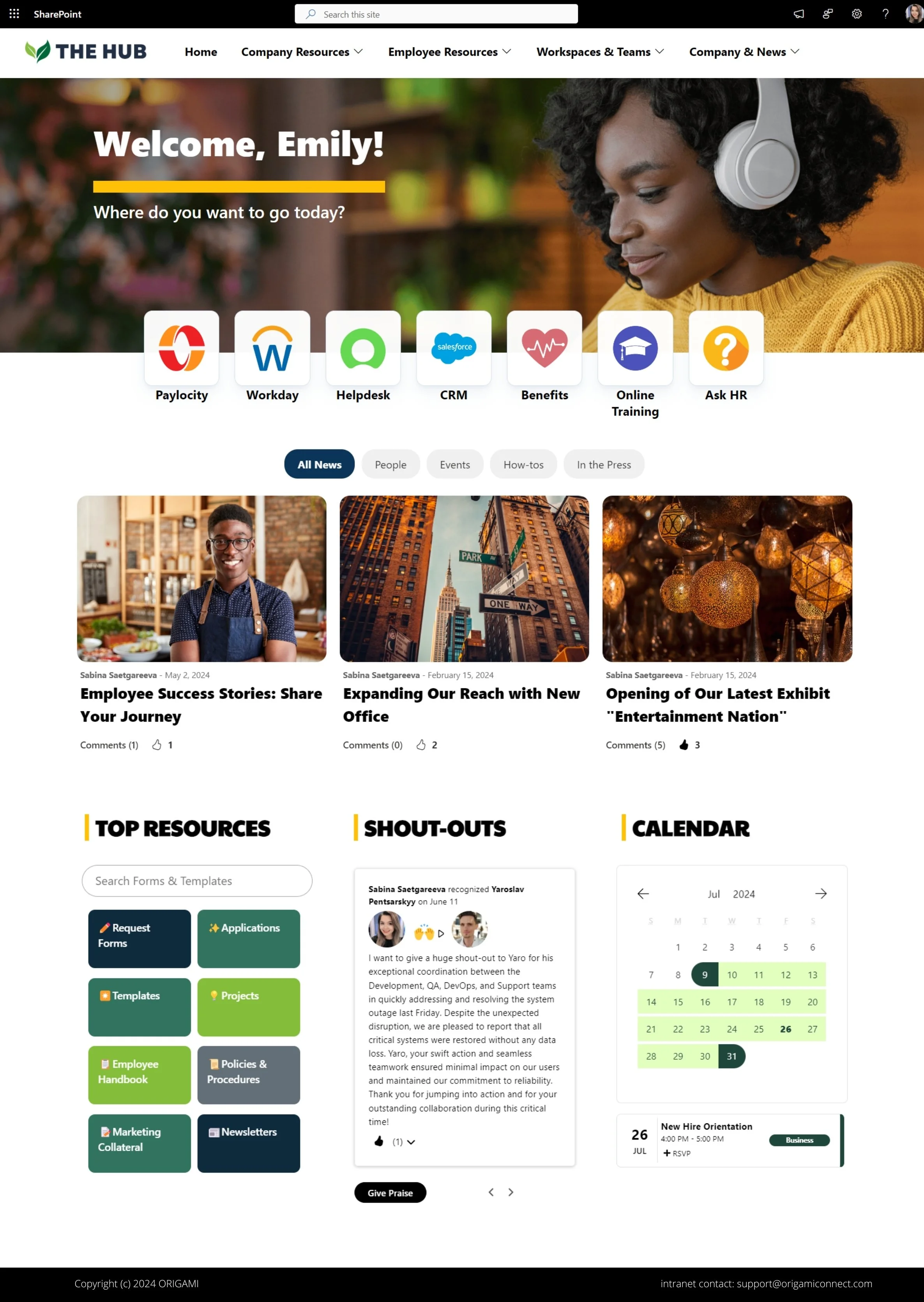Over the years of implementing various SharePoint intranet designs, the conversation with a customer typically starts with "what's important to you/what do you need"?
What I'll share here, are some of the most common modules a SharePoint intranet typically needs to be successful and relevant in a medium-sized organization. You can use these as intranet feature ideas for designing your own intranet.
1. Workspaces and Teams: Document Management
If you think of your SharePoint intranet as a city, Workspaces or Teams are your residential neighborhoods.
Workspaces or Teams are places for groups and departments in your company to form a close working community to get something specific done. This can be a project, a task force, an internal document repository of a department or a team.
Here are some typical workspace sites:
Project Sites
HR
Finance
Legal
Marketing
IT
Workspaces usually have restricted access with a select group of content contributors managed by a site owner.
Essential functionality expected on these sites includes:
Working together on documents and deliverables
Easily search for documents and projects
Track versions
Track tasks and ownership
This is an example of a Projects Directory in a SharePoint intranet, where users can search for their project site and access relevant documents.
2. Employee Tools: Employee Engagement
Employee tools are part of your cultural neighborhood in the intranet city. This is where employees go to find tools to help them to be productive and connect.
Typically this area of your intranet includes:
New Member Orientation Site
Ex: First Week
Ex: Ordering Business Cards
Ex: Equipment
Training
Benefits Information
Staff Forms
Policies and Handbooks
Career Growth
Staff Directory
Employee News and Events
(where team members can post their content even if it's moderated)
This area is generally open for everyone to read with a few select content contributors. It's important to clearly identify content contributors on your SharePoint intranet and we often display their names on the site so that if some content is missing or inaccurate, everyone knows who to contact.
Help users connect with the content contributor in a specific area of the SharePoint intranet if they find an error or missing information
3. SharePoint Intranet Tools/Resources for Business
Help employees quickly access tools they need to get their work done. This is the area where you keep all of the relevant business resources, links, and process information.
Here are some of the most common items we recommend in this section on your SharePoint intranet:
Process and Methodology Knowledge-base
Ex: Logo Usage Guidelines
Ex: Supplier Procurement Process
Templates and Sample Deliverables
Ex: Project Status Report Template
Ex: Project Plan Template
Request Forms
Ex: Marketing Collateral Ordering Form
Links to:
CRM
Reporting
Analytics
Help your users find content by tailoring each sub-section to the type of content.
For example, if your company provides services you can help your staff to easily find a company published white-paper or case study. Case studies are easier to find when they're in an article format rather than a document.
Here is the example of how you could present your case studies on a Marketing Resources site.
Illustrates how different content is presented on the SharePoint Intranet to draw attention to various sections of this department site helping users find what they're looking for.
4. SharePoint Intranet Communication
Communication is the bread and butter of any intranet site. In fact, many intranet initiatives are started by a communication department's need to effectively facilitate dialog between employees and the company. In a modern intranet, communication is not exclusively produced by the members of the Communications team, so what is this content?
Typically internal communication content goes right on the home page of the site with links to other sections on the intranet.
Here are the most common communication tools your intranet needs:
Urgent Company Alerts
Internal Company News & Events
Public and External Company Announcements
Employee Welcomes and Recognitions
Some other interesting elements include:
Department News
(targeted to logged in user)Message from Executive
KPI's
Opinion Polls
In Summary
As you can see, the modern intranet is dynamic and is all about what your team members need to get their work done. It doesn't duplicate information from other sources such as the public site content. It also doesn't try to be a replica for other specialized system such as the CRM.
It provides quick access, it's relevant, responsive and helpful.
Hope this helps in your upcoming intranet design strategies. Post your comments below, we’d love to hear your thoughts!
A Hassle-free SharePoint intranet.
Yaroslav Pentsarskyy is the Director of Product at Origami. He's also 8 time Microsoft MVP, speaker at many local and worldwide tech events, and a published author of several SharePoint related books.











See how we turned a default SharePoint homepage into a modern and stunning landing page.